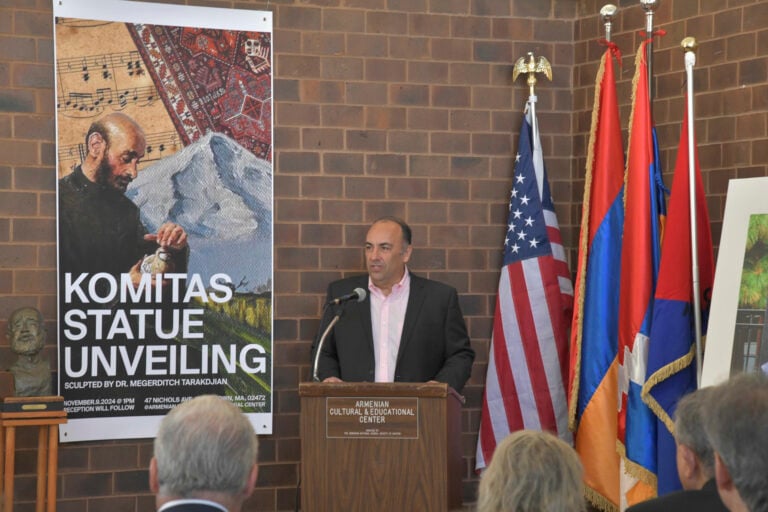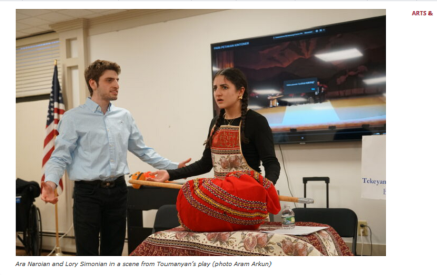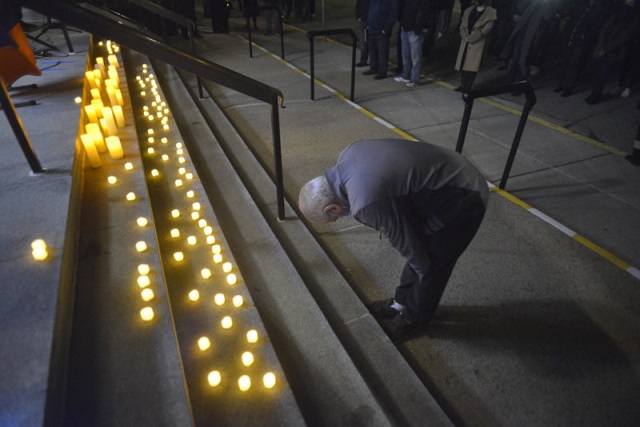The Armenian Weekly. The Armenian Cultural and Educational Center (ACEC) in Watertown, Massachusetts hosted a special event on Saturday, November 9 — the unveiling of a statue of Komitas prominently placed in front of the building.
The program began indoors to a full house of guests eager to view the statue, which was visible through the windows covered in a black cloth until the official unveiling. Displays dedicated to Komitas provided historical context and honored the legacy of the celebrated ethnomusicologist, courtesy of the National Association for Armenian Studies and Research (NAASR).
ACEC Trustee Josh Tevekelian offered the background behind the statue’s donation by its sculptor Dr. Megerditch Tarakdjian, a process which began with a phone call from Dr. Tarakdjian during the pandemic in 2020 and finally came to fruition this fall.
“Dr. Tarakdjian, on behalf of our community here in Boston and the ACEC, I want to thank you many times over for this tremendous gift and generous consideration bestowed upon our community,” Tevekelian said.
Read also
Dr. Tarakdjian is based in Montreal, Canada, and has honed his sculpting artistry over the last 25 years. His works can be found in private collections and on public display around the world. To name just a few: a monument to the iconic Armenian-Canadian photographer Yousef Karsh stands in Ottawa; the first ambassador of Armenia to the United States Armen Garo in front of the Armenian embassy in Washington, D.C.; and a statue of Paruyr Sevak in Zangakatun, Armenia, the poet’s birthplace.
Tevekelian also offered thanks to Toros Vosbikian, who sponsored the beautification of the area where the statue is located as well as the expense of its installation in honor of his father Hampartsoum Vosbikian, a friend of Dr. Tarakdjian.
Komitas and his legacy are well-known throughout the world, and in honor of the occasion, ACEC Board chair Dr. Vatche Seraderian highlighted his life and his contributions to the Armenian community and beyond.
“Komitas is often called the father of Armenian music,” Dr. Seraderian said. “His contributions go far beyond music, touching the soul of Armenian culture and identity. He was an ethnomusicologist, a composer, a singer, a musicologist and a priest. But above all, he was a visionary.”
Throughout his difficult childhood and later tragedies, Komitas’ talent was evident to those around him. “Komitas was a cultural pioneer who gave Armenia a musical voice. His efforts to preserve Armenian folk music ensured that Armenian culture would endure despite hardships and adversity. His music remains a bridge that connects Armenians to their roots and serves as a reminder to the strength and beauty of Armenian culture,” Seraderian concluded.
Following heartfelt remarks by Dr. Tarakdjian about the significance of the statue and his desire to donate it to the ACEC, pastor of St. Stephen’s Armenian Apostolic Church Very Rev. Fr. Hrant Tahanian addressed guests.
Very Rev. Fr. Tahanian explained the change in how the martyrs of the Armenian Genocide are remembered since the two Catholicoi canonized them in 2015 during the centennial, an “unprecedented event, because never before had such a large group of individuals been sanctified and canonized all at once.” Now, we pray to the sainted martyrs for intercession and they are celebrated, which included the composition of new hymns, he explained. One of the acolytes of Komitas, Archbishop Zareh Aznavorian of blessed memory, wrote a “masterpiece dedicated to our martyrs” in 1990, 25 years before canonization, in anticipation of the monumental occasion.
“Sadly, we did not have enough time to get accustomed to this new approach, because a few years later the Artsakh War started in 2020 and ended with the full exodus of the Artsakh population,” Very Rev. Fr. Tahanian said. He noted that on the eve of COP29 being held in Baku, November 10 had been designated by both Catholicos Karekin II and Catholicos Aram I as an international day of prayer. “As the Azerbaijani government continues to try to whitewash its crimes, we do not give up,” he said.
Very Rev. Fr. Tahanian then invited everyone outside for a brief prayer service and blessing with honored clergy Archpriest Fr. Antranig Baljian, Rev. Fr. Arakel Aljalian from St. James Armenian Apostolic Church, Very Rev. Fr. Ghazar Bedrossian of Holy Cross Armenian Catholic Church and Rev. Avedis Boynerian and the ceremonial unveiling of the Komitas bust.
“This is a significant gift because it adds value to the fabric of the institution for which it was gifted,” Tevekelian told the Weekly. “It allows us to remember that although we move forward with diverse programming and events which benefit our entire community, our beginnings are important, our history shapes that programming, and our allegiance to our past is important. We must strive to be the change we want to see in our community but remember that our past will always be our guiding light.”
The afternoon concluded with musical performances from Komitas’s repertoire featuring Very Rev. Fr. Bedrossian, accompanied on piano by Azadouhi Markarian, and the Boston Hamazkayin ArtNova Choir, led by music director Maestro Arthur Veranian.
The reception was courtesy of anoush’ella and owners Raffi and Nina Festekjian, along with the local Armenian Relief Society chapter members who generously provided desserts.





























































